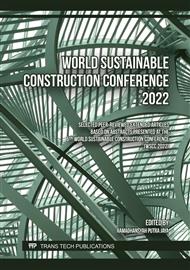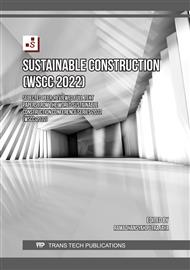[1]
H. Zhang, G. Xu, X. Chen, R. Wang, and K. Shen, "Effect of long-term laboratory aging on rheological properties and cracking resistance of polymer-modified asphalt binders at intermediate and low temperature range," Construction and Building Materials, vol. 226, pp.767-777, 2019.
DOI: 10.1016/j.conbuildmat.2019.07.206
Google Scholar
[2]
C. Liu, S. Lv, D. Jin, and F. Qu, "Laboratory Investigation for the Road Performance of Asphalt Mixtures Modified by Rock Asphalt–Styrene Butadiene Rubber," in Journal of Materials in Civil Engineering vol. 33, ed: American Society of Civil Engineers (ASCE), 2021, p.04020504.
DOI: 10.1061/(asce)mt.1943-5533.0003611
Google Scholar
[3]
Y. Jiao, Y. Zhang, L. Fu, M. Guo, and L. Zhang, "Influence of crumb rubber and tafpack super on performances of SBS modified porous asphalt mixtures," in Road Materials and Pavement Design vol. 20, ed: Taylor and Francis Ltd., 2019, pp. S196-S216.
DOI: 10.1080/14680629.2019.1590223
Google Scholar
[4]
A. Arshad, J. Ahmad, and K. Masri, "Rutting resistance of nanosilica modified porous asphalt," International Journal of Civil Engineering and Technology, vol. 10, no. 1, pp.2274-2284, 2019.
Google Scholar
[5]
F. Rachman and T. Syammaun, "Evaluation of asphalt porous mixture properties due to addition of Arenga pinnata and coconut fibers," in IOP Conference Series: Materials Science and Engineering, 2019, vol. 674, no. 1: IOP Publishing, p.012022.
DOI: 10.1088/1757-899x/674/1/012022
Google Scholar
[6]
N. E. Jasni et al., "Marshall stability of porous asphalt mixture incorporating kenaf fiber," Archives of Civil Engineering, vol. 68, no. 1, 2022.
Google Scholar
[7]
J. d. A. A. e. Silva, J. K. G. Rodrigues, M. W. de Carvalho, L. C. d. F. L. Lucena, and E. H. Cavalcante, "Mechanical performance of asphalt mixtures using polymer-micronized PET-modified binder," Road Materials and Pavement Design, vol. 19, no. 4, pp.1001-1009, 2018.
DOI: 10.1080/14680629.2017.1283353
Google Scholar
[8]
R. Ghabchi, C. P. Dharmarathna, and M. Mihandoust, "Feasibility of using micronized recycled Polyethylene Terephthalate (PET) as an asphalt binder additive: A laboratory study," Construction and Building Materials, vol. 292, 2021.
DOI: 10.1016/j.conbuildmat.2021.123377
Google Scholar
[9]
N. L. S. Ing, R. P. Jaya, and K. A. Masri, "Performance of Porous Asphalt Mixture Containing Seashell as Aggregate Replacement," Construction, vol. 1, no. 1, pp.18-28, 2021.
DOI: 10.15282/construction.v1i1.6275
Google Scholar
[10]
J. Choudhary, B. Kumar, and A. Gupta, "Utilization of solid waste materials as alternative fillers in asphalt mixes: A review," Construction and Building Materials, vol. 234, p.117271, 2020.
DOI: 10.1016/j.conbuildmat.2019.117271
Google Scholar
[11]
Open graded asphalt design guide, A. A. P. Association, 2004.
Google Scholar
[12]
N. Saboo, R. Ranjeesh, A. Gupta, and M. Suresh, "Development of hierarchical ranking strategy for the asphalt skeleton in semi-flexible pavement," Construction and Building Materials, vol. 201, pp.149-158, 2019.
DOI: 10.1016/j.conbuildmat.2018.12.131
Google Scholar
[13]
R. Pamungkas et al., "Design and properties of asphalt concrete with various plastic waste in dry processed," in IOP Conference Series: Materials Science and Engineering, 2019, vol. 578, no. 1: IOP Publishing, p.012079.
DOI: 10.1088/1757-899x/578/1/012079
Google Scholar
[14]
R. Putra Jaya, K. Masri, H. Awang, and M. Mohd Warid, "Stability and stiffness of asphaltic concrete incorporating waster cooking oil," International Journal of Recent Technology and Engineering, vol. 7, no. 6, pp.16-19, 2019.
Google Scholar



